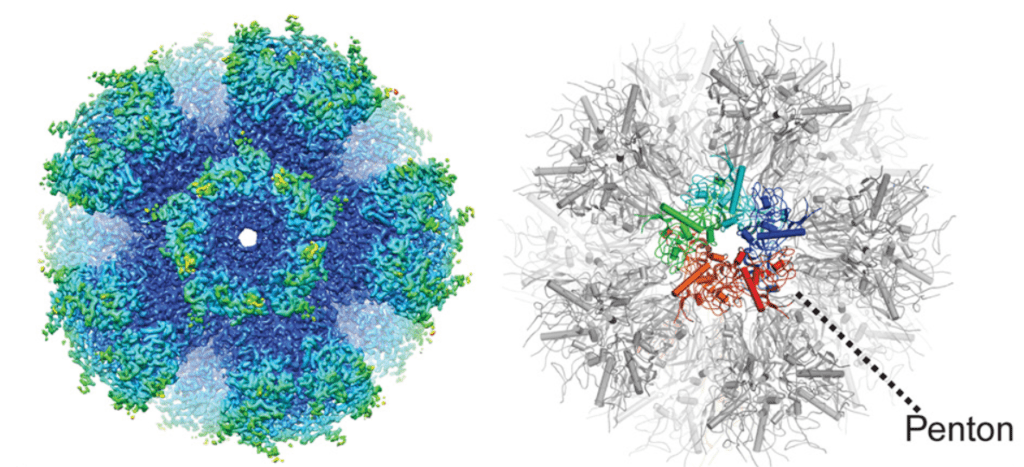A new, synthetic vaccine for the mosquito-borne virus Chikungunya has been developed by an international team of researchers with the help of tech giant Oracle. The findings give us a powerful new tool to use against the pathogen and points the way towards a shift in how vaccines are designed, produced, and stored.

Image credits Charles Vragniau et al., 2019, Science Advances.
The synthetic vaccine can be stored at warmer temperatures for long periods of time compared to traditional vaccines, meaning it doesn’t need to be refrigerated. It was developed by researchers from the University of Bristol and the French National Centre for Scientific Research (CNRS) in Grenoble, France, in collaboration with Oracle. The new vaccine relies on a synthetic protein scaffold that the team says can be applied to other vaccines in the future.
Digital vaccine
“Researchers have had a long tradition of building and installing their own super computers on-premises, but cloud computing is allowing them to run large data sets in record time, with fast connectivity and low latency,” explains Phil Bates, leading cloud architect at Oracle and a co-author of the study.
“Going forward, technologies like machine learning and cloud computing will play a significant part in the scientific world, and we are delighted we could help the researchers with this important discovery.”
Our best weapon today against infectious diseases isn’t actually a drug — it’s our own immune systems. But our immune systems do have one glaring limitation: it doesn’t know what pathogens are out there; instead, it learns by fighting them. Which means that the first time they come along looking for a fight, we’re at our weakest.
Vaccines work by presenting our bodies with inactivated or weakened viruses that it can fight and learn to recognize before the pathogen proper makes an appearance. All in all, it’s an amazingly powerful process: it eradicated smallpox, measles, polio, and tetanus, diseases which were very prevalent — and deadly — mere generations ago.
But recent epidemics (such as those of Zika and Ebola) show that we shouldn’t rest on our laurels. We have defeated some viruses, but more are ready and willing to take us on. Developing or underdeveloped countries are the most exposed to such pathogens as they lack the infrastructure and resources necessary to develop and deploy vaccines in adequate (if any) quantities. Outbreaks in such areas can cause widespread disruption and damage to local economies and communities.
Chikungunya, a virus transmitted by the bite of infected mosquitoes, is one of the top contenders on today’s scariest viruses list. The disease it causes is characterized by fever, crippling headaches, vomiting, swelling of limbs, and is potentially fatal. Even if the initial symptoms subside, Chikungunya can become chronic, leading to long-lasting, intense joint pain, insomnia, and extreme prostration. Chikungunya has for long been confined to Saharan Africa but is spreading around the world as its mosquito hosts leave their natural range due to deforestation and climate shifts. Cases have been reported in both the USA and Europe.
The new synthetic vaccine is stable at high temperatures, can quickly be modified, and is easy to produce, the team explains — making it well suited for both developed and developing countries.
“We were working with a protein that forms a multimeric particle resembling a virus but is completely safe because it has no genetic material inside, said Pascal Fender, expert virologist at CNRS. “Completely by chance, we discovered that this particle was incredibly stable even after months, without refrigeration.”
The surface of this particle is very flexible and “can be easily engineered”, adds Imre Berger, Director of the Max Planck-Bristol Centre for Minimal Biology in Bristol. The team inserted inactive fragments of the Chikungunya virus on its surface to create “a virus-like mimic we could potentially use as a vaccine.”
They used cryo-electron microscopy, a process that involves freezing a sample and then analyzing it with an electron microscope (and won a Nobel Prize), to validate their findings. Cryo-electron microscopy allows for viewing on a near-atomic level, which gives us a lot of data — in fact, it gives us way too much data. In order to make sense of it all, the team collaborated with Oracle.
Oracle allowed the use of their cloud infrastructure for the team to use as a base. The researchers developed a system through which they could feed their data and generate an accurate digital model of the synthetic vaccine molecule. The whole process took “a fraction of the time” and at “much lower costs” than seen before in similar work.
Animal studies performed after this step showed very promising results, the team adds.
“We were thoroughly delighted,” adds Imre Berger. “Viruses are waiting to strike, and we need to have the tools ready to tackle this global threat.”
“Our vaccine candidate is easy to manufacture, extremely stable and elicits a powerful immune response. It can be stored and transported without refrigeration to countries and patients where it is most needed. Intriguingly, we can now rapidly engineer similar vaccines to combat many other infectious diseases just as well.”
The paper “Synthetic self-assembling ADDomer platform for highly efficient vaccination by genetically encoded multiepitope display” has been published in the journal Science Advances.


